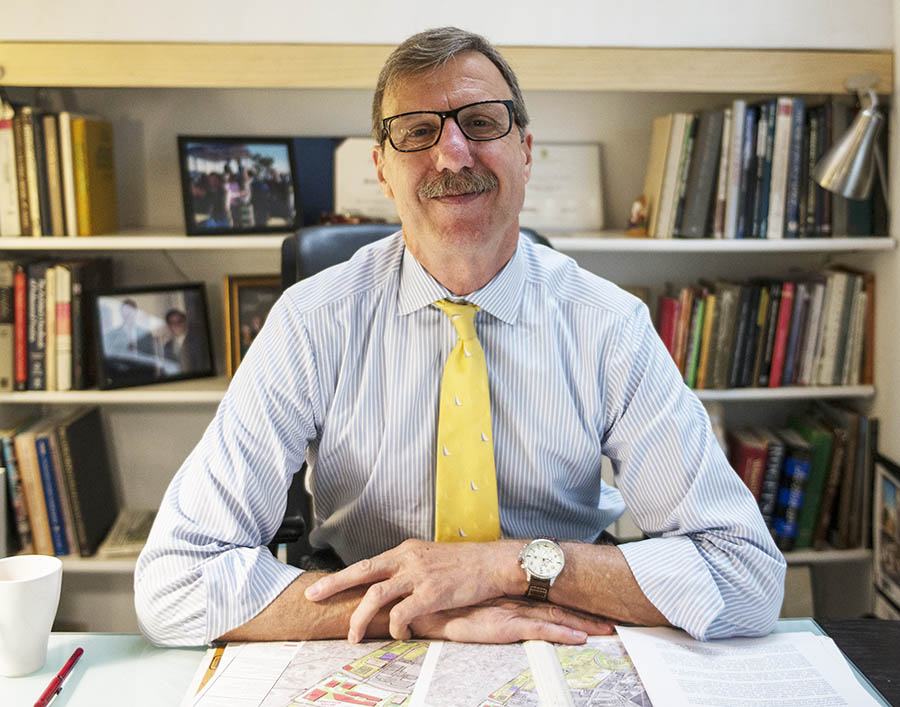
Managing Principal Brian Kite of SRK Architecture is a fourth generation Angeleno whose father was also an architect and whose great-grandparents ventured to Los Angeles in 1888. Kite truly identifies with the historical origins of the city and his current project, partial renovation of the Los Angeles Athletic Club, is one he calls a
labor of love.
Just within the Figueroa Corridor of Downtown Los Angeles (DTLA) off W. 22nd Street lies the cozy, slightly industrial office space of SRK Architects. On first glance, the loft-like structure housing architects and interior designers on one floor and engineers on the next, appears and feels almost sleepy with a bubbling undercurrent of quiet energy from the small staff. The firm’s sunny conference room gives visitors a glimpse into the many amazing projects SRK’s team has completed and/or is embarking upon, and Managing Principal Brian Kite, AIA, was on site to greet Downtown Weekly and provide the scoop on this unique architecture and interior design firm based in DTLA. One of SRK’s most important and highly visible projects is the current renovation of the Los Angeles Athletic Club (LAAC), a historic high-rise built in 1911.
In what Kite calls a “labor of love,” SRK has completed Phase 1 of the project, which included gutting, renovating and reconstructing the men’s locker rooms at the athletic club. The firm is now beginning work on the area where the women’s locker room will now be housed, which is to be completed within five months.
Next, the current women’s locker rooms (which are on another floor) will be demolished and construction will move down to the fifth and sixth floors where the new spa, barbershop, restaurant, pool and amenity areas will be included. The men’s spa has already been completed, and includes a whirlpool, steam room, sauna, showers, men’s lounge and several hundred NBA-style lockers, said Kite. Originally a men’s club, many of the Los Angeles Athletic Club’s improvements are culturally significant in terms of societal changes, particularly in regard to gender equality.
According to Kite, “The women’s facilities were built in the 50s and 60s” and were “very old and dilapidated” in comparison to the men’s facilities. With SRK’s new design plans, the men’s and women’s locker facilities will be on the same floor for the first time ever and will be “separated by a retail/reception lobby right off the main elevators on the fifth floor that will provide a new level of merchandising, reception and amenity for members that has never existed before,” said Kite. Today, the club’s membership has an approximate 60/40 male to female ratio, said Kite, but SRK has projected forward about 10 years to ensure equal accommodations for all members. “It’s exciting to do a generational update and take some of the history and carry that forward, but at the same time be a part of the new downtown and reflective of the kind of membership that the club wants to be,” said Kite.
During the revitalization process, Kite and the SRK team have worked closely with the Hathaway Family who has owned LAAC since its beginnings. As Los Angeles’ very first club, Kite explained that preserving the history of the space while also bringing the historic venue into the 21st century was particularly important to LAAC President and Managing Partner Karen Hathaway and General Manager Steve Hathaway. While the LAAC is a Beaux-Art-style clubhouse designed by famed architects John Parkinson [Los Angeles City Hall, the original Bullocks-Wilshire downtown building and the LA Coliseum] and George Bergstrom [US Pentagon], Kite describes the building as “fairly utilitarian” from an architectural perspective. Much of the building’s original design had to be re-worked to meet fire, safety and ADA (Americans with Disabilities Act) codes, said Kite.
Kite pointed out that it was important to the firm to be respectful of the history of the building, preserving the original architectural expression on the building’s exterior, while simultaneously bringing internal design elements forward to the 20th and 21st century. One key element of preservation was the SRK interior design team’s use of historic photos and elements that were incorporated throughout the finished space. The interior design staff poured through the basement of LAAC to discover, reframe and incorporate pieces of art that had been in storage, in some cases, 50 – 75 years. Another standout feature of the renovation will be a grand, winding staircase between the fifth and sixth floor of the building leading members and guests from the fifth floor reception/lobby area up the stairs to the spa and swimming pool. SRK literally cut a whole in the floor of the building to accommodate the major highlight.
The grand staircase will feature a large-scale bronze sculpture of Roman god Mercury in a pose of rising up, referencing the god’s role as a bridge between the upper and lower worlds. (Downtown Weekly was kindly treated to a sneak peek of the work by artist Richard Becker prior to its bronzing and it is truly spectacular. This will definitely be a must-see piece!) “That grand stair is going to be a relatively modern expression … as opposed to a historic stair,” said Kite. “We looked at doing a historic stair … but the modern codes just simply don’t allow it … you have to dilute the historic beauty so much because [of] the way the codes have changed, so rather than try to do that we just … decided that we should bring it into a contemporary expression that is also consistent with everything else.”
On the sixth floor of the building, many items will be preserved including the historic swimming pool, basketball courts covered by distinctive filigreed skylights, the ceiling treatments and the historic swimming pool. The LAAC is truly at the center of a tremendous amount of the city’s history including its famous early members, which include actors like Charlie Chaplin, Mary Pickford and Rudolph Valentino. The club’s cultural significance is what is being carried forward with SRK’s services, which includes architecture, interior design and implementation of major fixtures and equipment, including artwork. Referencing his most fond project LAAC, Kite states “it’s a lot of responsibility to renovate a John Parkinson building,” but the architect feels a certain kinship to the project. Kite is a fourth generation Angeleno whose father was also an architect and whose great-grandparents ventured to Los Angeles in 1888. Because of all of these factors, Kite truly identifies with the historical origins of the city.
“My own grandparents were in downtown Los Angeles in the 20s, and I don’t know if my grandfather and great-grandfather went to the LA Athletic Club … but my dad is about to turn 90 … and he can remember stories about LA Athletic Club. I have pictures of he and I playing basketball there not too long ago, so I feel very compatible with their mission to serve the downtown community at a time when downtown really has emerged in a way that it never has before. I’ve been working in and around Los Angeles since the late 70s and I’ve seen a couple of renaissances and this one is unlike anything that has happened before.”
At present, SRK’s two largest markets are workplace and hospitality. The firm’s completion of a new 160,000-square-foot corporate headquarters and regional distribution center for Walker Zanger in North Hills, Calif. is SRK’s newest workplace project. According to Kite, the commissioned re-design of Walker Zanger’s headquarters, which houses North America’s largest supplier of stone [and tile], was met with great fanfare. Last year, SRK also completed the Waterfront Building in Studio City, a renovation project along the LA River.
“We find that in the city of Los Angeles, it’s very difficult … other than in downtown … where sites that are formerly parking lots are turning into mega projects — and we have a couple of those too — they’re in their early stages, but renovating buildings, seismically upgrading buildings and essentially saving structures that are already in existence –- already entitled -– is a subject of a lot of developer interest all over the city, including downtown,” said Kite.
“The adaptive reuse ordinance, of course, in Downtown Los Angeles, has allowed the dispensation of old buildings for new uses and that’s been a very important part of the revitalization of Downtown Los Angeles, but it’s also existed throughout the city.” SRK is also working with high-tech El Segundo placement firm Chipton Ross to restore the company’s three-story space, which will include internal improvements, seismic upgrades and the addition of a roof garden for employees. According to Kite, the project is about three months from completion and the new garden area overlooks the Ballona Wetlands and the Pacific Ocean.
“Those are projects that you couldn’t very easily build today, so saving those projects is, of course, a sustainable act because it’s maintaining something that’s existed … it takes a lot less use of resources to save a building than it does to tear it down and build a new one,” said Kite. SRK firm members believe in incorporating all emerging aspects of sustainability into their work despite steady changes in sustainability, planning and design. Kite said, “The LEED certification process [a measure of sustainability] is the important mode of building certification that we all recognize … from LEED-certified to gold, platinum, therefore we have to be advocates to our clients …”
With that in mind, Kite also admits that selling sustainability in the public sector is a bit easier than in the private sector where utilities can be much more cost-prohibitive for clients and long-term benefits are not as readily appreciated. SRK takes a holistic view to sustainability and advocates and embeds these principles as much as possible and fully explains the costs/benefits to clients. Some of the Kite’s sustainable projects include the Tom Bradley LEED-certified terminal and the LEED-platinum Burbank Community Services building. Although the Chipton-Ross building is not LEED-certified, Kite said it is very green building “that incorporates the highest standards with respect to sustainability.” On the hospitality front, SRK will tackle generational updates for the historic San Pedro Elks Lodge that tragically burned partially in a fire about two years ago.
SRK will soon be ramping up construction on the structure originally built in 1965. The building holds enormous historical significance for local residents who have hosted weddings, funerals and other events at the meeting space at the top of San Pedro with “commanding views” of the Port of Los Angeles, the mountains, Downtown Los Angeles and even Newport Beach. “It’s [Elks Lodge] a very important part of the fabric of the community of San Pedro, so we were very pleased to be involved in this project,” said Kite. He continued, “It’s not a simple project, but it’s one of the things that, I would say, characterizes our practice. We tend to be involved in complex projects that are not your average, everyday, run-of-the-mill design or construction projects just because it’s sort of more interesting. We’re a firm that has grown up around renovation projects.” Considering SRK’s downtown location, Kite said the firm does focus quite a bit on downtown clients, but they also work to expand the practice.
For instance, SRK has worked on the sanctuary renovation of nearby St. Johns Episcopal Cathedral at Adams and Figueroa, and the firm now has a couple of projects in Chinatown. “Chinatown, I think, is … one of the segments of downtown that is going to become important in the future and, of course, the financial core of downtown has always been important, but I think Chinatown, in its own way is kinda the Northern hub of downtown [and] is going to emerge as an important player,” said Kite.
Kite stated that Chinatown’s proximity to Union Station, the historic birthplace of Los Angeles directly adjacent to the transportation hub and lack of development space in the city’s financial core are all reasons for significant developer interest in North Downtown. He believes developers will also expand to Central City West around Vermont and Wilshire. “We just completed a bridging document for a new, 16-story consolidation project with the County of Los Angeles Department of Mental Health on Vermont and 6th.”
In this effort, SRK assisted the Los Angeles County Development Commission in creating a solicitation to developers to design, build and operate for the county the new home of the Department of Mental Health. In addition to Chinatown, Kite believes the Figueroa Corridor will also play an important part in the city’s development. “USC has its own very ambitious plans and we’re going to see many more construction cranes around USC. The reason we’re [SRK] here … we like being downtown, but we don’t need to be right in downtown. You notice you didn’t have to take a ticket to come to see us … free parking in downtown Los Angeles … we have it … I can take the DASH and be at 6th and Fig [in] 15 minutes,” said Kite.
Kite, who ran a large corporate architectural firm in downtown LA for many years and was principal-in-charge for 1 million-square-foot renovation of Tom Bradley terminal at LAX explained, “large projects are great, but corporate architecture has got limitations because, if you are a large firm, you have a lot of mouths to feed … after really working for several large firms, as well as having my own firm early in my career, I decided that I really prefer to have a little closer control to the practice of architecture because I really found in a large practice, I wasn’t able to personally get involved … with my clients … the reason that a firm is hired is almost always the principal’s involvement in that project.”
Because of this, Kite and SRK Principal, Director of Operations Gabriel Avalos are personally involved in every single firm project. According to Kite, “Architecture is built on optimism. There’s no pessimistic client that’s ever hired an architect. If you’re pessimistic, then you’re just not going to be building.” As the son of an architect, Kite loves the profession and still sketches and designs at times. “Associate Principal Hugo Calderon, is our chief designer, but I serve as the design principal and managing principal in a dual role simply because I think the integrated architecture — the integration of design and the documents it takes to build a building — need to be completely one in the same.” He added, “Construction is a very difficult process … a messy process; we feel like, if we’re not willing to go through that, then we’re not really doing our job as architects. Our desire is not to become the largest firm in Los Angeles or Downtown Los Angeles … What we want to do is be limited in our size, but focused on providing the highest level of service we possibly can, which is to have a completely integrated design and working drawings and fully integrated architecture, engineering and interior design process. We won’t do one of those disciplines and not the other. If you don’t want the whole enchilada, you can’t buy it from us.”











